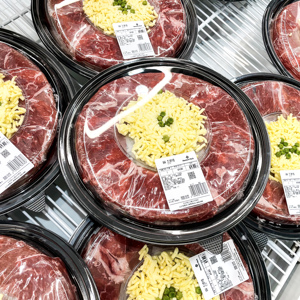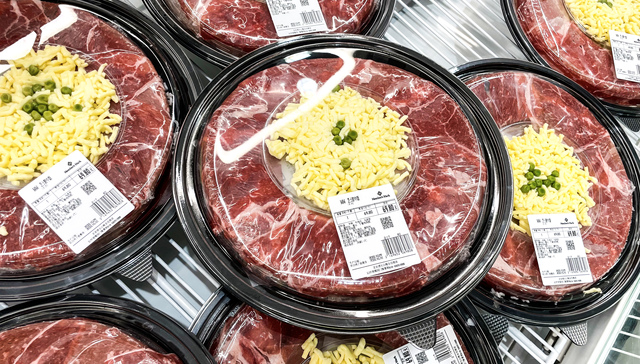By MA Yue, WU Rong
When it comes to restaurant food, most people think of dishes prepared by a team that does everything from chopping to garnishing. But nowadays, the dishes are more likely cooked and portioned in a central facility and cooked in a much scaled-down kitchen.
Sometimes the restaurant does not even have a kitchen. The cook (also the manager and cashier, maybe the cleaner), simply heats up the dish and ships it out. In the age of food delivery, ghost kitchens, and franchising, ready-to-cook is the new trend for the restaurant business.
Hot dinner, cool trillion
The same goes for home cooking. Big-box stores and gourmet supermarkets alike are competing to attract food-obsessed and time-pressed millennials and GenZs. The choices go far beyond frozen soup dumplings and lunch meat. You can even find rare seasonal delicacies such as Yangtze River anchovies.

Sales of ready-to-cook food in China grew 21 percent to 420 billion yuan (US$57.69 billion) in 2022, according to market research company iiMedia. The market is expected to exceed 1 trillion yuan by 2026. Over 80,000 companies are registered in the business, including artisan producers and publicly listed conglomerates with market caps of as much as 50 billion yuan.
To be clear, ready-to-cook has been around for a long time. But demand was never as high, and products were not as varied.
If you cook it at home, it's home-cooked
Delisi, a meat producer, started making ready-to-cook products for restaurants in 2015. It invested 20 million yuan and hired a team of chefs, who developed hundreds of marinated meats for commercial kitchens. But restaurants back then were resistant to buying processed ingredients. CP Group entered the market even earlier, in the early 2000s. For a long time, it didn’t even touch the Chinese market, selling to convenience stores in Japan instead.
The pandemic completely changed the game. The popularity of food delivery gave rise to a whole new type of restaurant, whose business model depends on getting as many dishes out of the door in as little time as possible.
Restaurant chains expanded fast and had to find new ways to standardize recipes and lower costs. Homebound consumers also became receptive to meal kits. The new habits stuck after the pandemic.
Food companies expanded capacity and signed new deals with grocery stores. Investors took notice too. Guolian Aquatic received US$ 560 million from the Saudi Arabia sovereign wealth fund. HaiXin Foods reportedly is negotiating a 520-million-yuan funding round for its ready-to-cook business. Increased investment also led to much vertical integration and innovation in the industry.
Many cooks make better broth
A lot of science goes into ready-to-cook food to preserve the flavor and texture of ingredients during processing, packaging and shipping. Food companies either raise their own meat or buy from suppliers who can produce to specifications.
Zhongyang Group breeds a type of algae-eating catfish that doesn’t become rubbery or pungent after a few days in supermarket fridges. Guoquan Shihui, a brand that supplies hot-pot and barbecue ingredients harvests crawfish early in the shell-shedding season so that the stir-fries are not all shells and no meat. Chicken producer Fengxiang developed a pounding technique that makes vacuum-packed chicken breasts juicy without much damage to the muscle fiber.
To lower costs and increase capacity, human workers are being replaced with machines. Yanji, a restaurant equipment company, makes 57 types of blades to dismember and slice different parts of a chicken. There is another set of blades for fish. One of its clients, a hot pot restaurant, slices 8 tons of fish a day in its central kitchen. Human cooks could only process 2 tons a day.
Slow food moves fast
For shipping, flash freezing is widely used to minimize cell damage and nutrition loss. If the food is perishable, warehouses and shipping routes are set up to shorten the time spent on the road. The logistics get complicated when many ingredients are involved.
Delisi often has to process, pack, and ship each ingredient for a single dish differently – a double-cooked pork it sells to restaurant clients. The pork bellies can be sliced, marinated, and frozen in a factory. But scallion, chili pepper and ginger are better fresh. More food science goes into a single-pack version that can be assembled in home kitchens.
Not like grandma used to make
Still, the perception of ready-to-cook dishes as inferior to made-from-scratch ones is here to stay. Even food company executives admit that thawed seafood is spongy, and microwaved stir-fries do not have “the breath of a wok” – the hearty flavor unique to fresh-off-the-stovetop dishes.
For now, the solution doesn’t go beyond selling pre-flavored and pre-portioned raw ingredients, so that restaurants or individual customers can simply tear open the packages and perform the last few crucial steps themselves. Not a perfect one. But the food scientists are still hard at work.





